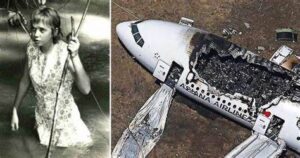 It seemed like a simple matter of a choice. Juliane Margaret Beate Koepcke, who was born on October 10, 1954, was set to graduate in Lima, Peru on December 23, 1971, and she wanted to attend her graduation ceremony before flying home to Panguana with her mother, Maria Koepcke. Juliane the only child of German zoologists Maria (née von Mikulicz-Radecki; 1924–1971) Maria and Hans-Wilhelm Koepcke (1914–2000). Her parents were working at Lima’s Museum of Natural History when she was born. When Juliane was 14, the family left Lima to establish the Panguana research station in the Amazon rainforest, where she learned survival skills. Unfortunately, the educational authorities didn’t allow this type of “schooling” and she was required to return to the Deutsche Schule Lima Alexander von Humboldt to take her exams and graduate. Maria really wanted to leave on December 19th or 20th, but she finally agreed that her daughter could stay longer. So, they scheduled a flight for Christmas Eve. All the flights were booked except for one with LANSA, an airline that Juliane’s father, Hans-Wilhelm had urged his wife to avoid flying with due to its poor reputation. Disregarding the warning, Maria booked tickets on LANSA flight 508.
It seemed like a simple matter of a choice. Juliane Margaret Beate Koepcke, who was born on October 10, 1954, was set to graduate in Lima, Peru on December 23, 1971, and she wanted to attend her graduation ceremony before flying home to Panguana with her mother, Maria Koepcke. Juliane the only child of German zoologists Maria (née von Mikulicz-Radecki; 1924–1971) Maria and Hans-Wilhelm Koepcke (1914–2000). Her parents were working at Lima’s Museum of Natural History when she was born. When Juliane was 14, the family left Lima to establish the Panguana research station in the Amazon rainforest, where she learned survival skills. Unfortunately, the educational authorities didn’t allow this type of “schooling” and she was required to return to the Deutsche Schule Lima Alexander von Humboldt to take her exams and graduate. Maria really wanted to leave on December 19th or 20th, but she finally agreed that her daughter could stay longer. So, they scheduled a flight for Christmas Eve. All the flights were booked except for one with LANSA, an airline that Juliane’s father, Hans-Wilhelm had urged his wife to avoid flying with due to its poor reputation. Disregarding the warning, Maria booked tickets on LANSA flight 508.
Mid-way through the flight, the plane was struck by lightning. The plane actually began to disintegrate before plummeting to the ground. Suddenly, Juliane found herself, still strapped to her seat, falling 10,000 feet into the Amazon rainforest. Amazingly, she survived the fall, but she was injured. She suffered a broken collarbone, a deep cut on her right arm, an eye injury, and a concussion. Juliane then spent 11 days in the rainforest, most of which were spent making her way through water by following a creek to a river. Apparently, no one knew  that she was there, or that she was missing from the wreckage of the plane. The jungle is a very unforgiving place for those without some kind of protection, and Juliane found herself dealing with severe insect bites and an infestation of maggots in her wounded arm. I’m sure that she could not believe that after surviving a fall of 10,000 feet, she might die in the jungle from whatever animal or insect might attack her. Nine days into her ordeal, she came upon an encampment that had been set up by local fishermen. There, she was able to at least give herself basic first aid. It was crude, however, and included pouring gasoline on her arm to force the maggots out of the wound. Then, she waited. After a few hours, the returning fishermen found her, gave her proper first aid, and used a canoe to transport her to a more inhabited area. Finally, she was soon airlifted to a hospital.
that she was there, or that she was missing from the wreckage of the plane. The jungle is a very unforgiving place for those without some kind of protection, and Juliane found herself dealing with severe insect bites and an infestation of maggots in her wounded arm. I’m sure that she could not believe that after surviving a fall of 10,000 feet, she might die in the jungle from whatever animal or insect might attack her. Nine days into her ordeal, she came upon an encampment that had been set up by local fishermen. There, she was able to at least give herself basic first aid. It was crude, however, and included pouring gasoline on her arm to force the maggots out of the wound. Then, she waited. After a few hours, the returning fishermen found her, gave her proper first aid, and used a canoe to transport her to a more inhabited area. Finally, she was soon airlifted to a hospital.
Many experts have tried to speculate as to how Juliane could have possibly survived. Some said that she survived the fall because she was harnessed into her seat, the window seat, which was attached to the two seats to her left as part of a row of three. They thought that somehow that functioned as a sort of parachute which slowed her fall. Some thought that the impact may have also been lessened by the updraft from a thunderstorm Koepcke fell through, as well as the thick foliage at her landing site. Juliane wasn’t the only passenger to have survived the initial disaster. Approximately 14 other passengers were later discovered to have survived the initial crash, but sadly, all of those died while waiting to be rescued. After recovering from her injuries, Koepcke assisted search parties in locating the crash site and recovering the bodies of victims. Her mother’s body was discovered on January 12, 1972. Juliane says, “I had nightmares for a long time, for years, and of course the grief about my mother’s death and that of the other people came back again and again. The thought ‘why was I the only survivor?’ haunts me. It always will.”
Juliane returned to her parents’ native Germany, where she fully recovered from her physical injuries. Like her parents, she studied biology at the University of Kiel and graduated in 1980. She received a doctorate from Ludwig Maximilian University of Munich and returned to Peru to conduct research in mammalogy, specializing in bats. She published her thesis, “Ecological study of a bat colony in the tropical rain forest of Peru”, in 1987. In  1989, Koepcke married Erich Diller, a German entomologist who specializes in parasitic wasps. After her father died in 2000, she took over as the director of Panguana. Today, she serves as librarian at the Bavarian State Collection of Zoology in Munich. Juliane’s autobiography “Als ich vom Himmel fiel: Wie mir der Dschungel mein Leben zurückgab” (German for When I Fell from the Sky: How the Jungle Gave Me My Life Back) was released in 2011. The book won that year’s Corine Literature Prize. In 2019, the government of Peru made her a Grand Officer of the Order of Merit for Distinguished Services.
1989, Koepcke married Erich Diller, a German entomologist who specializes in parasitic wasps. After her father died in 2000, she took over as the director of Panguana. Today, she serves as librarian at the Bavarian State Collection of Zoology in Munich. Juliane’s autobiography “Als ich vom Himmel fiel: Wie mir der Dschungel mein Leben zurückgab” (German for When I Fell from the Sky: How the Jungle Gave Me My Life Back) was released in 2011. The book won that year’s Corine Literature Prize. In 2019, the government of Peru made her a Grand Officer of the Order of Merit for Distinguished Services.


Leave a Reply